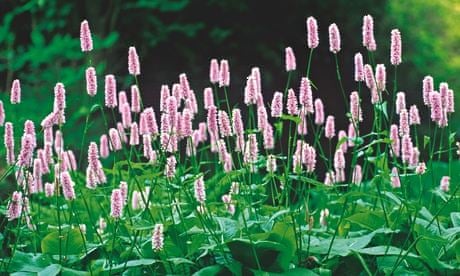I love March. It brings the same level of excitement as a Thursday evening. You're through the worst bit and tantalisingly close to the good times. But anticipation can lead to impatience and mistakes. You know the drill: first sunny day of the year and the smell of cut grass is in the air; you rush to the garden centre and buy whatever looks colourful, anything to cover up the bare earth you've been staring at for months.
Garden centres know this and they're ready for you – they put out whatever they can muster to satisfy your desire for colour. But if you want fast results, don't be tempted by the plants on the centre-stage benches; go for the quiet-looking ones tucked away in the aisles.
These hardy herbaceous perennials may look like just a pot of soil now, but planting them will be like letting a wild animal out of its cage. If you're the impatient type and have large spaces but a small budget, these plants will be perfect. But be warned – they're bar-room brawlers, so throw them in with like-minded types and let them fight it out. A group planted together in an area of naturalised grass will give you a shabby-chic, prairie look.
The plume poppy (Macleaya microcarpa) is one of my favourites. It's fast, good-looking, and though it'll grow to 7ft tall in one season, it won't fall over. It prefers sun but will cope with partial shade, and in dry soil it almost behaves itself. It's tough, too: it'll laugh in the face of a -10C winter's night. The beige flowers appear in mid- to late-summer as plumes that brighten to orange in the evening sun. 'Kelway's Coral Plume' has a good strong colour, but don't let its charm trick you. It's still a rogue – which will become apparent if you plant it in moisture-retentive soil. But handle it like that cuddly little teddy bear creature at the start of the film Gremlins: if it gets wet, it multiplies uncontrollably and that can get ugly.
If you have a slightly shady and boggy area where not much grows, try Euphorbia griffithii 'Dixter'. In late spring and early summer, this little firecracker produces masses of orange-red flowers that are so bright it looks as though it's wearing a high-visibility vest. Everything about it is colourful; even the undersides of the leaves and stems are a warm reddish colour. It grows to 2-3ft and is a champion marathon runner, so make sure you have room for it. But a large mass of that bright colour gives off a luminous glow.
Common bistort (Persicaria bistorta) will grow to about 2ft and in late spring and early summer produces lots of delicate, pink flower spikes. The cultivar 'Superba' has much larger flower spikes, but will need staking.
For something taller in an area of grassland, try Himalayan knotweed (Persicaria wallichii). Don't put this 6ft bruiser among delicate plants in your borders – it's too powerful – but it's great among tough lawn grass. In early- to mid-autumn it is covered in masses of scented white flower plumes.
Planting Clark's geranium (Geranium clarkei) in your borders is a bit like painting a colour wash on a canvas before you compose the main picture. This pretty little tough guy will creep through your borders at ground level, producing violet or white flowers. It won't interfere with the larger plants growing above it, and by covering the ground will keep the weeds at bay.
However, if your blood pressure won't cope with unruly behaviour but you still want the excitement of fast-growing plants, try something that's still fast-growing but much more obedient. Top of my list is Chinese silver grass (Miscanthus sinensis 'Malepartus'). It's beautiful, dramatic, is unbothered by pests or diseases and is reliable. Every year, you know you're going to get 6-8ft of pure magic. If you don't have time to be in the garden every weekend, these are the characteristics you need. It's also one of those rare plants that looks good in summer, autumn and winter. In October, when things are beginning to look sorry for themselves, the plumes of reddish-brown flowers are very welcome. And its ghostly winter silhouette looks especially good with a sprinkle of frost on top. In March, cut back the old stems to about knee-high and it'll soon produce a new set.
For more conventional flower power, try Helianthus 'Lemon Queen'. This perennial member of the sunflower family will grow 6-8ft tall and is sturdy enough to stand on its own feet without help. In midsummer, it's smothered in small, pale, yellow sunflowers that stay until long into the autumn. Bees love it, too.
For something a bit smaller and also popular with bees, try the Russian sage, Perovskia 'Blue Spire'. If you have a dry patch of soil in a sunny spot, this is for you. It grows about 4ft high and produces loads of lavender-blue flowers from midsummer to autumn. It loses its felt-like grey leaves in winter, but the silvery white stems still look good. Prune it back hard in spring.

Comments (…)
Sign in or create your Guardian account to join the discussion